Quick search
CTRL+K
Quick search
CTRL+K

Gaborone is Botswana’s capital, and the distinctive parliament building stands central to the city’s main axis as part of the large government headquarters. There is a beautiful park in front of the parliament and just in the middle of the city you will enjoy the positively relaxed atmosphere that characterizes the capital. The park is a great place to enjoy a stroll or as a starting point for a walk through the Government Quarter or the Main Mall.
The National Museum and Gaborone’s cathedrals are some of the sights where you can see and experience part of the culture that prevails in Botswana. Thus, the museum has a wide collection of everything from art to a Rhodesia Railways carriage. It is a great place to explore the country’s culture and history.
There are also markets in Gaborone. They are located on the main shopping street Main Mall, which link the parliament in the west and Gaborone’s town hall in the east. At the Main Mall you can find various art, which is also the case in the small artist colony Thapong Culture Center. Several major market areas and shops can be visited at the city’s railway station area and in some other neighborhoods.
There is great opportunity to take a closer look at the country’s wildlife and the nature around Gaborone, which west of the city quickly becomes the Kalahari desert. The desert divides Botswana and Namibia. The Gaborone Dam is just a short drive south of the city and drive a bit further to get into South Africa.
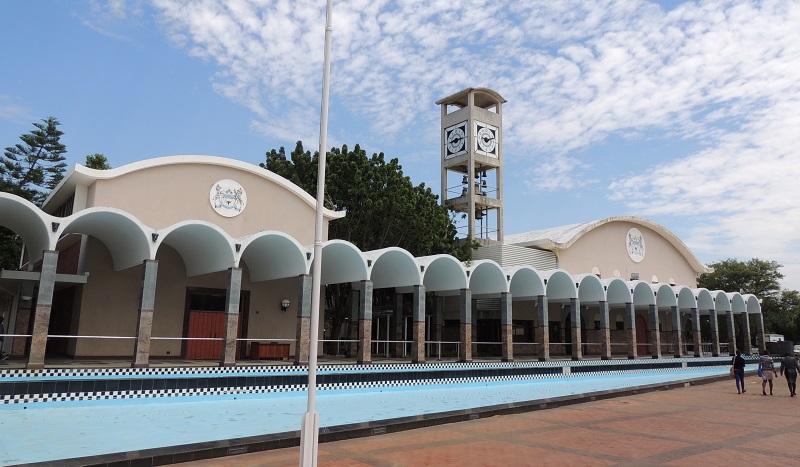
The National Assembly is the name of the legislative assembly in Botswana, and the assembly constitutes the only chamber of the country’s parliament. The majority of the members of the assembly are elected by direct election in single-person constituencies.
Parliament elects the country’s president, who has both the role of head of state and head of government. Parliament also has an advisory body, it is the so-called Ntlo ya Dikgosi, which means House of Chiefs. It is a non-political body composed of, among others, the leaders of Botswana’s leading tribes; baKgatla, baKwêna, baMalete, bamaNgwato, baNgwaketse, baRolôlong, baTawana and baTlôkwa.
The parliament buildings with their characteristic arches were built in conjunction with the establishment of Gaborone after Botswana’s independence. The buildings form the western end of the city’s central axis, which runs through the Main Mall.
The Main Mall is Gaborone’s pedestrian street and promenade, located in the heart of the capital. Around the Main Mall you can see modern buildings with shops, eateries, banks etc., and they lie like pearls on a string.
Here you can also look at a number of handicrafts and other things sold from various stalls. In the central square is the hotel Cresta President, from which there is a view of the Main Mall. At the eastern end of the street is the Pula Arch. It forms the end of the axis that goes here from the parliament in the west.
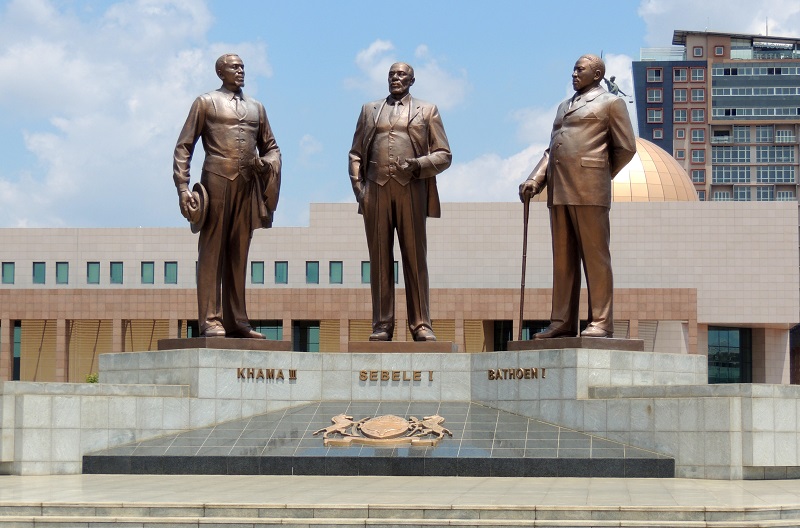
Three Dikgosi Monument is a monument with statues of three tribal leaders with the title of dikgosi, which is inherited. The three leaders are respectively Khama III of the baNgwato tribe, Sebele I of the baKwena tribe and Bathoen I of the baNgwaketse tribe.
The actual statues on the monument measure over five meters in height and were produced from bronze. The monument was erected to commemorate the three leaders’ contribution to Botswana’s independence. In 1885, they traveled to London to ask the British Colonial Secretary Joseph Chamberlain and Queen Victoria to separate the protectorate of Bechuanaland from Cecil Rhodes’ British South Africa Company and Southern Rhodesia, which is present-day Zimbabwe. The wish was granted, and it helped pave the way for the later establishment of the country of Botswana.
The Three Dikgosi Monument was inaugurated in 2005 by President Festus Mogae. It was built by the North Korean company Mansudae Overseas Projects.
Christ the King Cathedral is the Roman Catholic cathedral in Gaborone. Catholicism came to Bechuanaland, present-day Botswana, in connection with the International Zambezi Mission, which Pope Leo III authorized on 16 February 1879. Two months later, Jesuits started the mission itself consisting of four bullock carts with six priests and five monks from Grahams Town in South Africa. They reached different places in today’s Botswana.
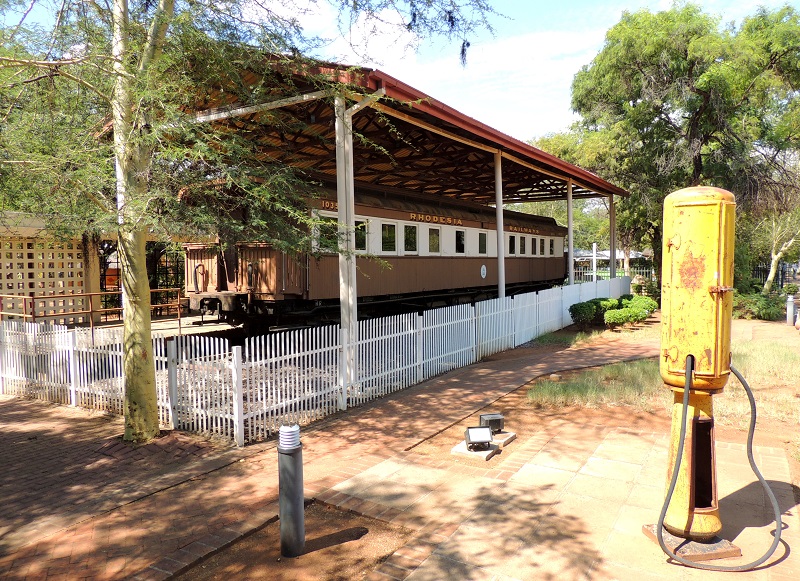
This is the National Museum of Botswana which was founded in 1967. That was the year after Botswana’s independence. Here you can see the country’s history and cultural diversity communicated, and there are also various handicrafts and several paintings.
You can also see larger effects at the museum. On the street south of the museum there is, for example, a railway carriage from Rhodesia Railways. The carriage was donated to the museum by the Railway Company of Zimbabwe.
As an institution, the Botswana National Museum also has other roles than dissemination at this museum. It is, for example, involved in the maintenance of Tsodilo in northwestern Botswana. Tsodilo is the country’s first inclusion on UNESCO’s world heritage list, and the site offers more than 4,500 petroglyphs.
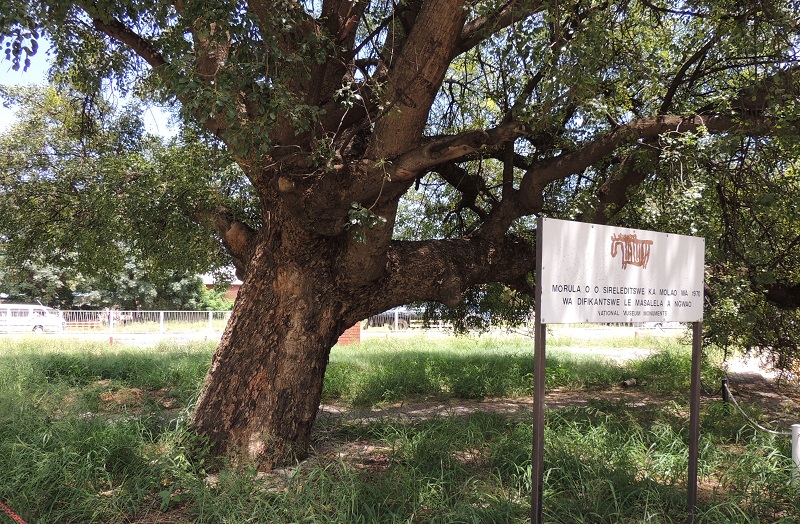
The Morula Tree National Monument is an over 100-year-old maruela tree that was protected as a national monument in 2001, as the Botswana Democratic Party held its first public meeting under the tree in 1962.
The Botswana Democratic Party was founded by Botswana’s later first president, Seretse Khama, in 1961. Before independence in 1966, it was called the Bechuanaland Democratic Party. In the first vote leading up to independence, the party won 28 out of 31 seats.
Thapong Visual Arts Center is an arts and crafts center housed in a house and grounds that were formerly the seat of the District Commissioner. The centre’s purpose is to support art development and artists from a local perspective. Among the active artists here are painters, carpenters, potters and weavers, and it is an experience to see their work.
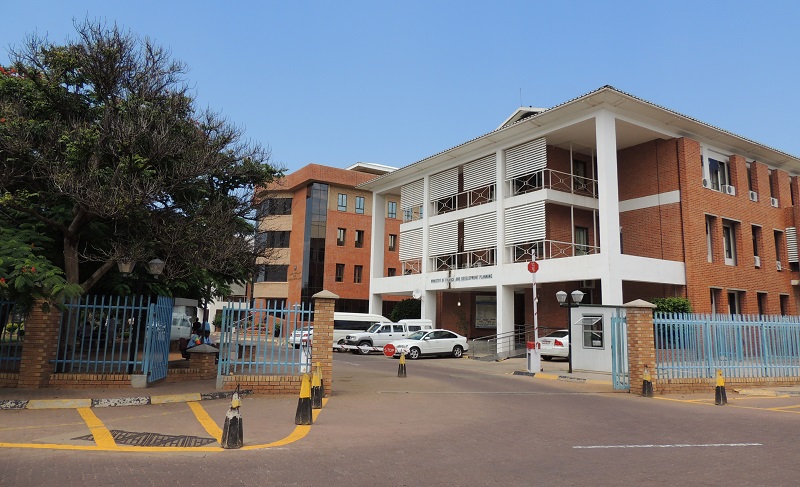
The Government Enclave is a centrally located area in Gaborone where Botswana’s political-administrative functions are located. This applies, among other things, to the national assembly in the parliament building, several ministerial buildings and the country’s presidential office.
In the area there are several monuments, such as a monument for those who died from Botswana in World War II and one for those who died during Zimbabwe’s war of independence.
Already shortly after the establishment of the Bechuanaland protectorate in 1885, a prison was established. An existing post office building was used and remodeled, and over time the facilities were significantly expanded.
The prison was used until the 1970s, when a new and modern prison was built as a replacement, and on that occasion the first prison was renamed The Old Prison. Today it as one of Gaborone’s historic buildings.
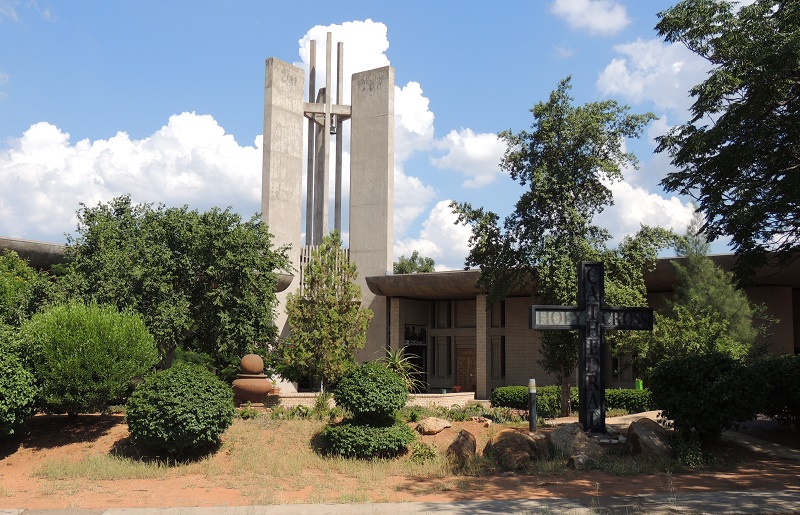
The Cathedral of the Holy Cross is the Anglican cathedral in Gaborone. It is an elegant and modern church building both externally and internally, where you can enjoy a bright church space that brings together the complex’s two building wings.
The National Botanical Garden is Gaborone’s botanical garden. It is located on a seven-hectare area where you can see and experience part of Botswana’s flora. The garden opened in 2007, and it is divided into six areas that correspond to botanically different regions of the country: Chobe, Okavango, Mophane, Northeast Kalahari, Mashatu and Southwest Kalahari.
Here is also a natural history museum, the Natural History Museum, which is housed in the Gaborone Rest House, which was built around 1890. The Gaborone Rest House was used as a hotel and hostel by some of the then British administrators of Bechuanaland.
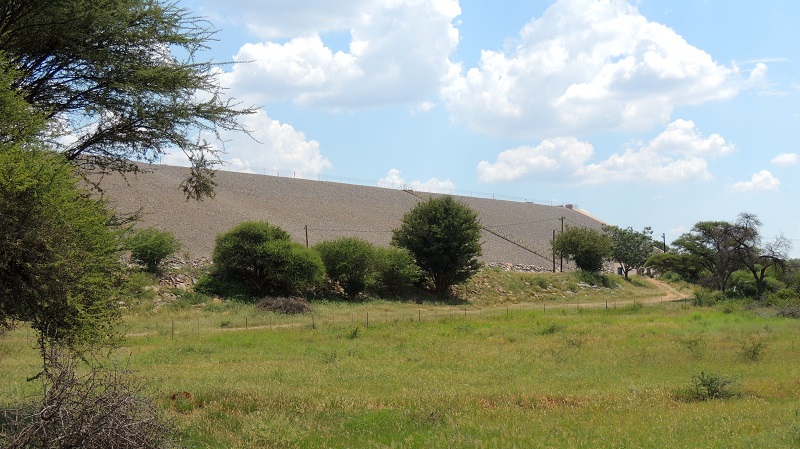
Gaborone Dam is a dam that spans the Notwane River, creating a reservoir with a capacity of over 140 million cubic meters of water. The reservoir provides water to both the capital Gaborone and to nearby Lobatse.
The original dam was built in the years 1963-1964 at the time when the construction of Gaborone was on the drawing board. To increase capacity, the dam was increased by seven meters in height in the years 1983-1985.
With Gaborone’s increasing water consumption, the water level at the Gaborone Dam is a critical factor for the city’s operations, and with several years of less rain and greater evaporation, major restrictions have been placed on water consumption.
The reservoir behind the dam is also used for several recreational purposes. Here you will find a number of parks, play areas, fishing spots and the Gaborone Yacht Club. However, you cannot bathe in the water due to crocodiles and parasites.
The Gaborone Game Reserve is a 600-hectare area where you can experience some of Botswana’s wild animals at close range. The reserve was established in 1988, and here you can see, among other things, a number of different antelope species, ostriches, warthogs and an interesting selection of the country’s birds.
Mokolodi Nature Reserve is a 30 square kilometer area established in 1994 as a combined zoo and research and education center for Botswana’s wildlife.
Among the many animals in the reserve are zebra, giraffe, kudu, eland, hippopotamus and rhinoceros, and it is thus a good place to experience a large part of this part of Africa’s fauna.
Main Mall
Main Mall
National Museum & Art Gallery
Independence Avenue, Pula
botswana-museum.gov.bw
Gaborone Game Reserve
Limpopo Drive
Living in the Notwane River area has been around since the Stone Age. Over time, there were various tribes that characterized the culture and development of present-day Botswana.
More recently, the so-called mfecane period took place in the early 1800s. It was a time when the batswana ethnic group became dominant.
Boers In the 1830s, the Boers started their great migration from the Cape Colony in the southwest to the northeast in today’s South Africa and Botswana, among others. The migration progressed while there were internal tribal settlements in the region, with several going to, for example, present-day Zambia and Zimbabwe.
The mid-19th century was also the time when European missionaries came to Africa to a large extent. In this connection, David Livingstone established a church and school in 1845 at the Kolobeng Mission; near Gaborone, which was not yet a city at that time.
In the 1880s, the Gaborone of the Batloko tribe left the South African province of Magaliesberg, heading for the area that later became southeastern Botswana. Here he founded the settlement Moshaweng, which European settlers called Gaborone Village or later simply Gaberones.
One of the early plants in the city was the fort of the mining magnate Cecil Rhodes, which served as a colony administration. The fort’s location later became the place where the real Gaborone grew.
In 1871 gold was found in South Africa, which later became of great importance to Cecil Rhodes’s interests in the South African colonies.
The British Protectorate of Bechuanaland was established in 1885, and it achieved a high degree of self-government through local chiefs. In 1889, Cecil Rhodes formed the British South Africa Company with royal permission, and this company became the British colonial government in the region.
Through the British South Africa Company, Cecil Rhodes wanted control of all the colonies of southern Africa, and this led three chiefs to travel to London in 1895. Here they were represented by Queen Victoria, who approved their wish not to include Botswana in British South Africa Company or other British colonies such as South Rhodesia.
The time from the Chiefs’ visit in the late 1800s to the independence of Botswana in 1966 became a period when Gaberones remained a small town with no character of the capital it was soon to become. Botswana as a whole also remained in a limited development such as the Protectorate of Bechuanaland, where, for example, the raw materials that helped to improve the economy significantly after the country’s independence were not yet found. In 1964, Gaborone had less than 4,000 inhabitants. It was one like a larger village that in a few decades would grow to more than 200,000 inhabitants.
In 1965, the Protectorate of Bechuanaland’s capital was moved from Mafeking to Gaberones, and when the country gained independence the following year, the election also fell on Gaberones as its capital, with the first wish Lobatse proved too limited in terms of development opportunities.
Gaberones was chosen because it had sufficient water resources, it was close to connections to Pretoria, it was centrally located in relation to the tribes’ settlements in the country, and then finally it was already colonial capital.
On September 30, 1966, the independence of Botswana was a reality, and in the new capital Derek Jones became the first mayor.
The new capital of Botswana is listed as a planned city. The plant started in 1964, and the city plan laid out large areas for walking areas and squares to create an airy city with urban spaces for citizens. After three years of construction, the basics of the city were completed and the capital was gradually taken into use. In 1969, Gaberone’s name changed to Gaborone.
Since then, developments have continued at a rapid pace, with urbanization and increased trade and other business having created the basis for many new buildings and general growth in Gaborone. The city today stands modern, but at the same time as the quietness that was planned for the new city in the 1960s.

Gaborone, Botswana
Overview of Gaborone
Gaborone is Botswana’s capital, and the distinctive parliament building stands central to the city’s main axis as part of the large government headquarters. There is a beautiful park in front of the parliament and just in the middle of the city you will enjoy the positively relaxed atmosphere that characterizes the capital. The park is a great place to enjoy a stroll or as a starting point for a walk through the Government Quarter or the Main Mall.
The National Museum and Gaborone’s cathedrals are some of the sights where you can see and experience part of the culture that prevails in Botswana. Thus, the museum has a wide collection of everything from art to a Rhodesia Railways carriage. It is a great place to explore the country’s culture and history.
About the Whitehorse travel guide
Contents: Tours in the city + tours in the surrounding area
Published: Released soon
Author: Stig Albeck
Publisher: Vamados.com
Language: English
About the travel guide
The Whitehorse travel guide gives you an overview of the sights and activities of the Canadian city. Read about top sights and other sights, and get a tour guide with tour suggestions and detailed descriptions of all the city’s most important churches, monuments, mansions, museums, etc.
Whitehorse is waiting for you, and at vamados.com you can also find cheap flights and great deals on hotels for your trip. You just select your travel dates and then you get flight and accommodation suggestions in and around the city.
Read more about Whitehorse and Canada
Canada Travel Guide: https://vamados.com/canada
City tourism: https://visitwhite-horse.ca
Main Page: https://www.vamados.com/
Buy the travel guide
Click the “Add to Cart” button to purchase the travel guide. After that you will come to the payment, where you enter the purchase and payment information. Upon payment of the travel guide, you will immediately receive a receipt with a link to download your purchase. You can download the travel guide immediately or use the download link in the email later.
Use the travel guide
When you buy the travel guide to Whitehorse you get the book online so you can have it on your phone, tablet or computer – and of course you can choose to print it. Use the maps and tour suggestions and you will have a good and content-rich journey.


The Morula Tree National Monument is an over 100-year-old maruela tree that was protected as a national monument in 2001, as the Botswana Democratic Party held its first public meeting under the tree in 1962.
The Botswana Democratic Party was founded by Botswana’s later first president, Seretse Khama, in 1961. Before independence in 1966, it was called the Bechuanaland Democratic Party. In the first vote leading up to independence, the party won 28 out of 31 seats.
Thapong Visual Arts Center is an arts and crafts center housed in a house and grounds that were formerly the seat of the District Commissioner. The centre’s purpose is to support art development and artists from a local perspective. Among the active artists here are painters, carpenters, potters and weavers, and it is an experience to see their work.

The Government Enclave is a centrally located area in Gaborone where Botswana’s political-administrative functions are located. This applies, among other things, to the national assembly in the parliament building, several ministerial buildings and the country’s presidential office.
In the area there are several monuments, such as a monument for those who died from Botswana in World War II and one for those who died during Zimbabwe’s war of independence.
Already shortly after the establishment of the Bechuanaland protectorate in 1885, a prison was established. An existing post office building was used and remodeled, and over time the facilities were significantly expanded.
The prison was used until the 1970s, when a new and modern prison was built as a replacement, and on that occasion the first prison was renamed The Old Prison. Today it as one of Gaborone’s historic buildings.

The Cathedral of the Holy Cross is the Anglican cathedral in Gaborone. It is an elegant and modern church building both externally and internally, where you can enjoy a bright church space that brings together the complex’s two building wings.
The National Botanical Garden is Gaborone’s botanical garden. It is located on a seven-hectare area where you can see and experience part of Botswana’s flora. The garden opened in 2007, and it is divided into six areas that correspond to botanically different regions of the country: Chobe, Okavango, Mophane, Northeast Kalahari, Mashatu and Southwest Kalahari.
Here is also a natural history museum, the Natural History Museum, which is housed in the Gaborone Rest House, which was built around 1890. The Gaborone Rest House was used as a hotel and hostel by some of the then British administrators of Bechuanaland.
Similar to Gaborone Travel Guide
